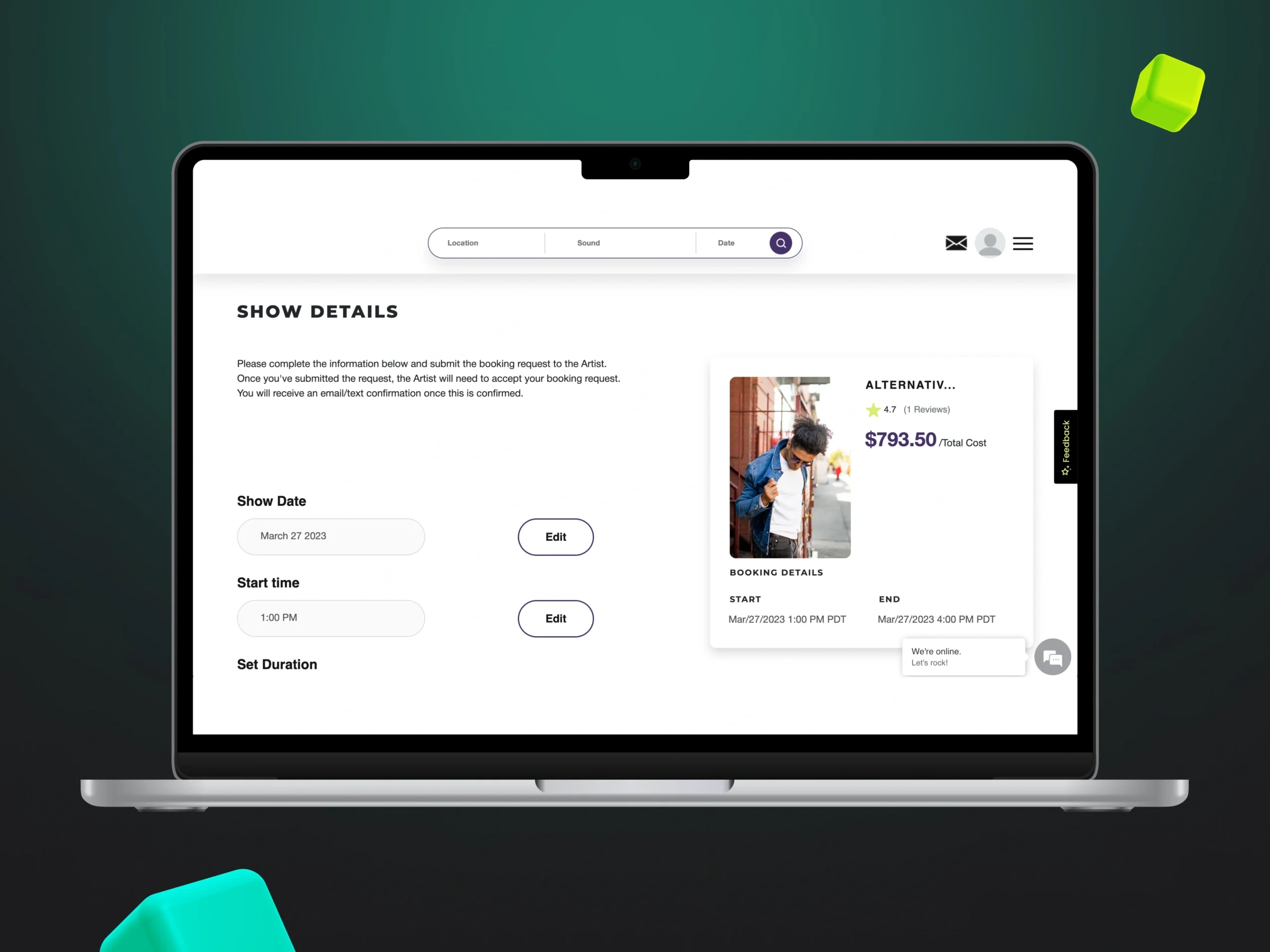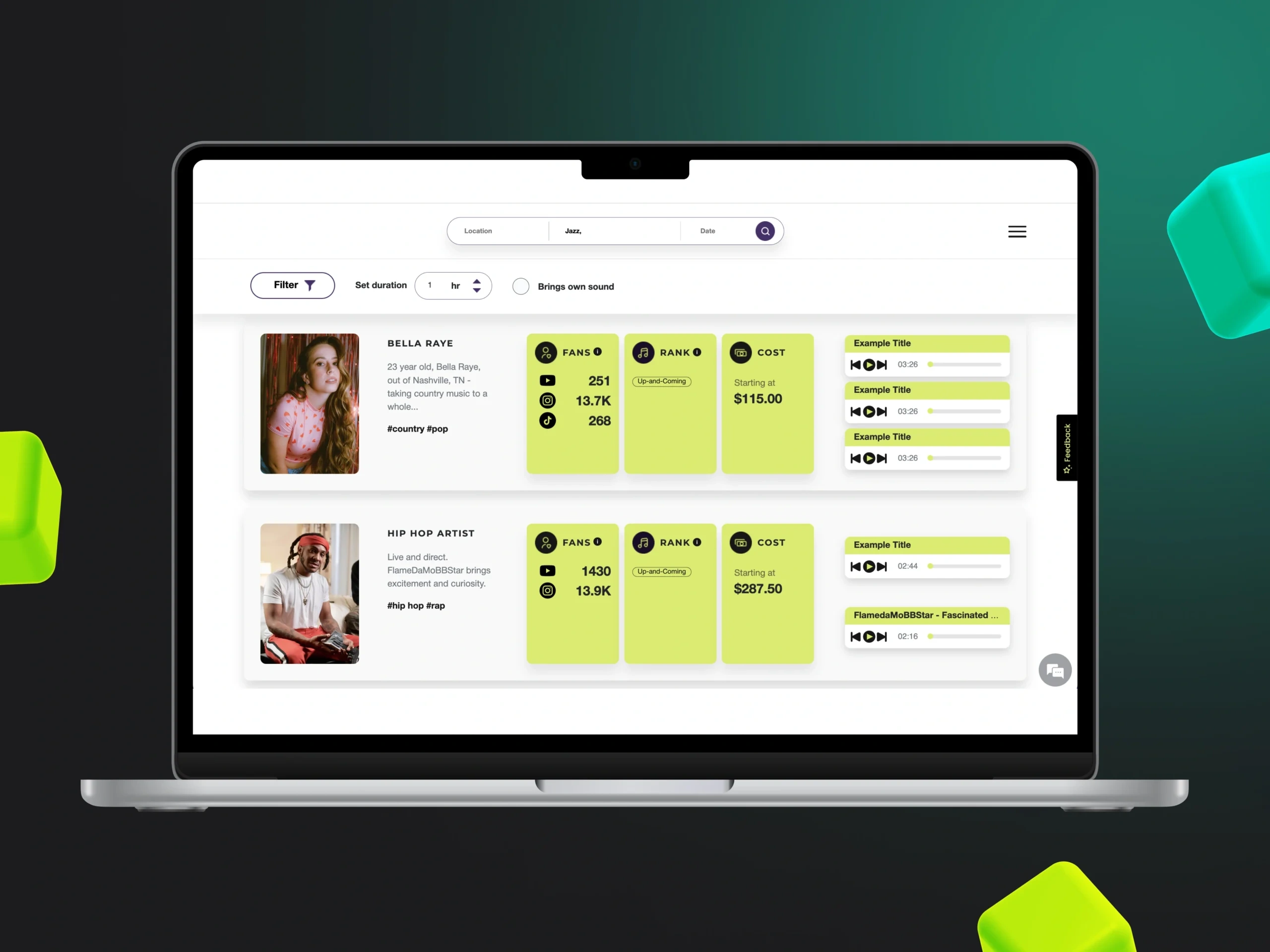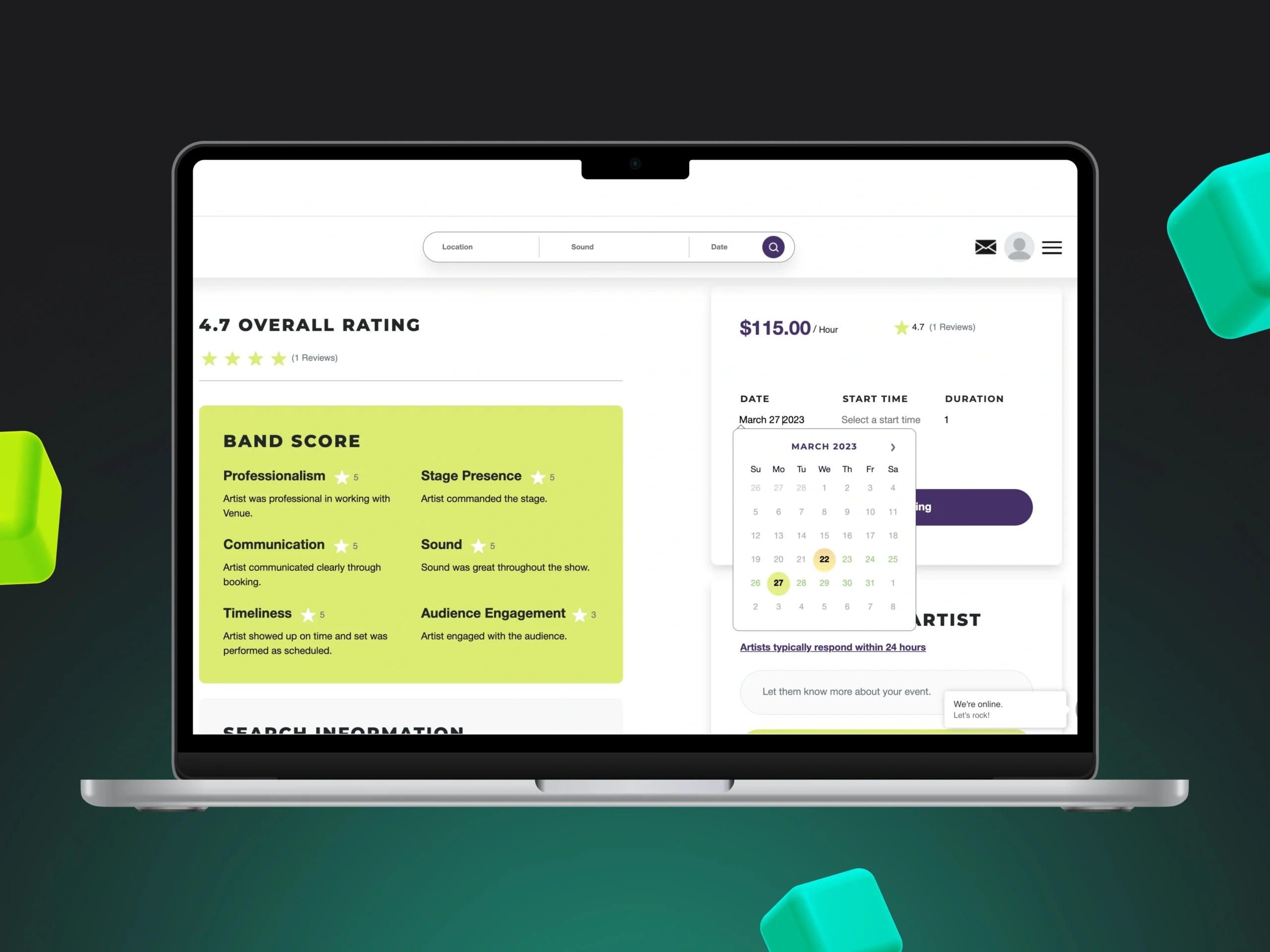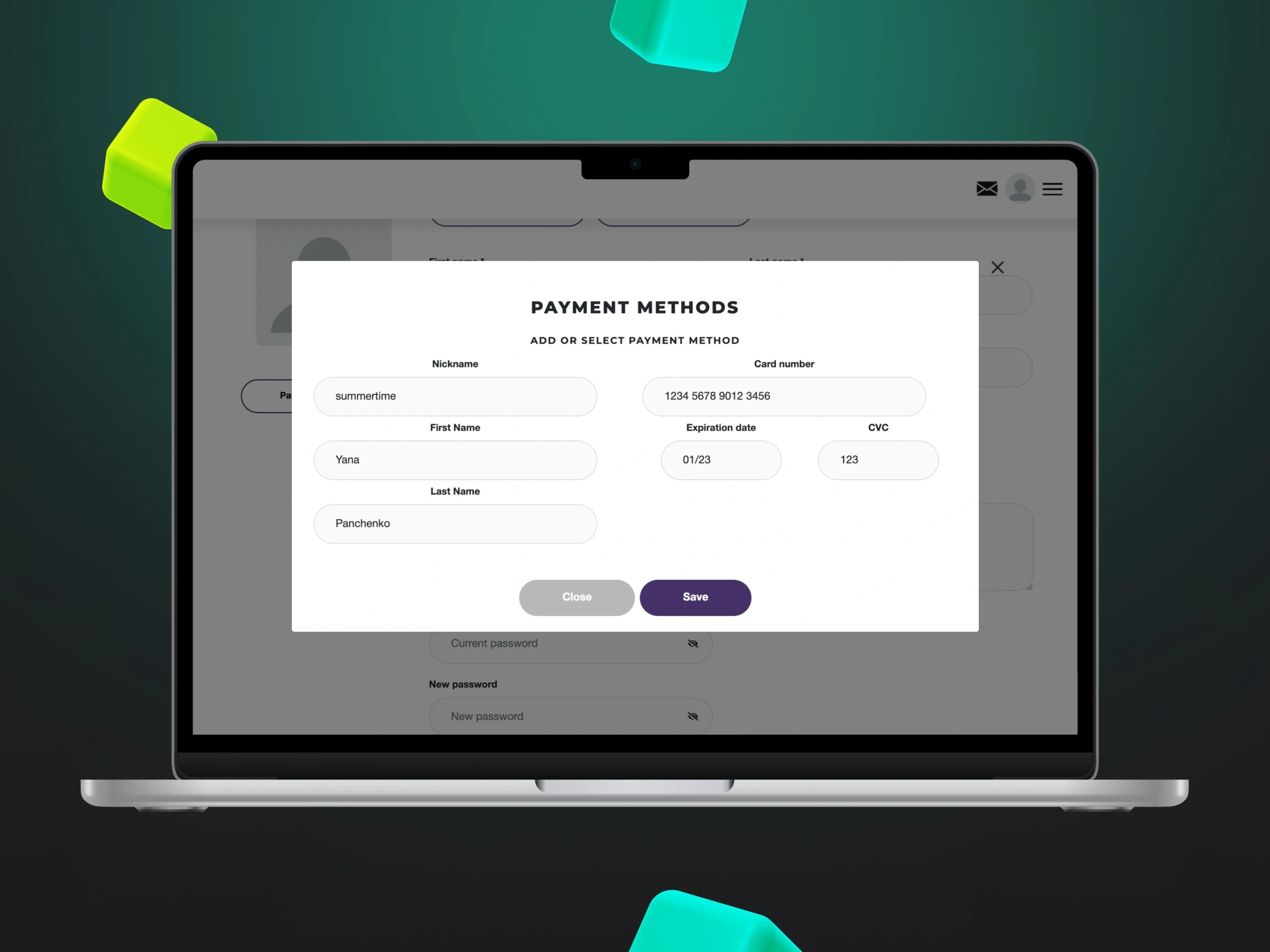
In our previous article, we explored a common dilemma faced by many product owners: should you launch your product on an existing marketplace or build your own e-commerce platform? If you’ve already made the bold decision to create your own marketplace, congratulations – you’ve taken the first big step. But now comes the part that often keeps founders awake at night: how do you bring this idea to life?
What should the first version include? How do you ensure it doesn’t fall apart as it grows? What’s the smartest technology stack? And most importantly, how do you create something people will actually want to use?
We’ve decided to share a case study of a product we developed for a client and tell you how we helped one of our clients go from concept to launch a fully functioning, scalable music marketplace. You’ll learn what really matters when building a digital platform from scratch, how to avoid common mistakes, and why choosing the right development partner can make all the difference in your success.
Whether you’re still sketching your idea or already deep into planning, this story contains real lessons and tested ideas to help you turn your market vision into reality.
Starting with the Right Foundation: Audience and User Journey Analysis
Our client came to us with a strong vision: to create a space where independent artists and venues could easily find each other and book performances without the usual friction. Imagine something halfway between a creative talent board and a booking assistant – but fully online.
But even the best idea can fail without the right foundation. So, instead of jumping straight into development, we started with what truly matters: understanding the people who would use the platform.
To make sure we were solving real problems, not making assumptions, we began by asking the client some important questions:
- How do artists currently find venues to perform at?
- What pain points do venue managers experience when booking talent?
- What tools (if any) do both sides use?
Next, we tested how this would work in real life. We created detailed user personas and outlined key journeys, such as:
- An artist applying for a performance at a venue with limited seating
- A venue that needs talent for a themed event at the last minute
- Mutual feedback after a performance.
We also immediately noticed some red flags – for example, what happens if someone cancels a performance at the last minute or if an artist can’t showcase their past concerts. This helped us identify the priority features that needed to address these issues from day one.
By focusing on real user behavior, we avoided the classic trap of creating features “just because they sound cool.” Instead, we focused on real-world scenarios that would immediately make the platform useful and trustworthy.

This phase didn’t just define the MVP – it gave the entire product a direction that was practical, aligned with business goals, and loved by users from the very beginning.
Building for Growth: Designing a Scalable Architecture
Scalability can’t be added later – it needs to be built into the foundation from day one. This is especially important for marketplaces, where there are multiple types of users, dynamic content, and many real-time interactions. Our goal for the client’s product was to ensure the platform could grow with demand without requiring a complete overhaul in six months.
We approached the architecture with a modular, service-oriented mindset. Instead of building a monolithic system, we broke it down into logical domains:
- User roles and permissions (artists, venues, administrators)
- Profile management
- Search and discovery (with filters like genre, location, availability)
- Booking system and calendar synchronization
- Secure payments and payouts
- Admin panels and content moderation tools.
This modular approach allowed us to develop and test features independently, improving time-to-market and boosting system resilience. For example, if the search feature needs an update later, it won’t affect the booking or payment modules.
We also chose a tech stack that supports rapid iteration: Laravel for backend logic, PostgreSQL for structured data, and Vue.js for dynamic frontend interaction. This gave us flexibility while ensuring future performance. Importantly, this system also allowed us to integrate additional features later, like AI-driven artist recommendations, mobile app integration, or even a streaming module, without reworking the entire system.
You can think of this like plumbing in a house: you may not install the jacuzzi yet, but it’s better to make sure the pipes are ready for it.
What to Include in a Music Marketplace MVP
Now we’re getting to the most exciting part – launching a marketplace, especially in the early stages when there’s always the temptation to add too many features too quickly. We’ve seen many founders rebuild their MVPs, hoping to impress with a multifunctional product, only to end up with a complex, hard-to-manage platform. But here’s the thing: an MVP doesn’t mean offering everything at once. It’s about getting the core functionality right, proving your idea, and leaving room for future growth.
For this music marketplace project, we knew that simplicity and focus were key to the platform’s success in the early stages. We worked closely with our client to determine the essential features that would solve real problems for artists and venue managers. Here’s what we focused on:
- Artist and Venue Profiles: These weren’t just basic profiles. We allowed users to upload media, showcase their talents, and provide detailed descriptions, setting the stage for meaningful interactions.
- Availability Calendar: A calendar that syncs schedules for both artists and venues. This simple yet powerful tool eliminated scheduling confusion and saved everyone valuable time.
- Booking System: A seamless request/confirm workflow that streamlined the entire booking process, ensuring that both artists and venue managers could confidently book and confirm performances.
- Integrated Payments: We integrated Stripe for fast, secure, and hassle-free transactions. This made it easy for users to pay and get paid, without the headaches of complicated payment systems.
- Search and Filtering: The ability to search based on key criteria like music genre, location, and availability meant that users could quickly find the right match – artists or venues – for any given event.
- Notification System: Simple email alerts and confirmations kept everyone in the loop, ensuring that no one missed important details.
The key here was to resist the temptation to add “bells and whistles” that, while interesting, wouldn’t immediately benefit early users. Features like social networking, AI-based recommendations, or advanced analytics were included in the roadmap for future updates, after the core functionality was solid and tested. By prioritizing essential features, we were able to launch the platform faster, confident it would meet users’ needs, with a clear vision of how to evolve it over time.

This approach ensured the platform remained lightweight, easy to use, and forward-thinking, while delivering tangible value right from the start.
Mistakes Avoided Thanks to Experience
Building a digital product, especially a marketplace, can be a thrilling yet perilous journey. Many startups fail, not because they run out of funding or creativity, but because they skip critical steps in the early stages or overcomplicate things before truly understanding their audience’s needs. As experienced developers, we’ve seen it all — the product with great ideas but poor execution. So, how did we make sure our client’s music marketplace didn’t fall into the same traps? Here’s how:
Unclear User Flows
One common mistake is rushing into development without prototyping and testing the user flows. Early user feedback is gold. Instead of assuming how users would interact with the platform, we invested time in creating simple, intuitive wireframes and prototypes. We tested them with real users to iron out pain points and refine the flow, ensuring that the experience would feel natural from the first interaction. This helped us eliminate confusion and ensured that both artists and venues would intuitively understand how to use the platform.
Payment Issues
Payment issues can derail an online marketplace faster than you can say “transaction error.” Too many products fail because payment gateways are implemented late in the process or not tested thoroughly. From the start, we made sure to integrate a robust, secure payment gateway — Stripe — which would allow fast, safe transactions. By doing this early, we minimized the chances of payment failures or security concerns down the line, making sure both users and our client were set for a smooth financial experience from the very first booking.
Misaligned MVP Features
One of the biggest pitfalls of launching an MVP for a digital marketplace is adding features based on assumptions rather than real-world user needs. We avoided this by sticking to the real pain points we identified through market research and stakeholder interviews. The result? A lean MVP with only the most essential features: profiles, booking, payments, and notifications. This kept the platform focused, functional, and free from unnecessary complexity. Every feature in the MVP had a clear reason for being there and directly addressed a challenge that users faced. We knew the importance of creating a marketplace platform that was simple yet effective.
Tech Debt
Another common issue for growing platforms is accumulating tech debt — code that’s quick to write but difficult to maintain or scale. We avoided this trap by following clean code principles and using scalable frameworks. By designing the architecture with scalability in mind from the beginning, we ensured the platform could easily grow as demand increased, without running into costly redevelopment or performance bottlenecks later. This approach is key when you aim to build an online marketplace that can scale as it grows.

Thanks to the experience we’ve gained over the years, we approached this project with a strategy that prioritized thoughtful planning and phased validation. By keeping our focus on the core user needs and following best practices for online marketplace management software, we were able to launch the MVP in a lean yet highly functional state. This not only reduced risk but also allowed our client to move quickly and efficiently — a crucial advantage in today’s fast-moving digital landscape.
Whether you’re looking to create your own marketplace, build an online marketplace, or start your own online marketplace, the journey can be daunting. But by adhering to best practices, leveraging the right marketplace technology, and following a solid digital marketplace strategy, you can increase your chances of success. Building a marketplace app or website — especially a multi-vendor marketplace website — takes thoughtful design, clear MVP goals, and careful attention to user needs. Don’t rush; focus on the basics, and you’ll be well on your way to creating a virtual marketplace that not only works but grows with your business.
Tools That Support Fast Iteration Without Sacrificing Performance
One of our top priorities when developing a scalable product according to the client’s vision is always choosing the right technology stack — one that can iterate during the MVP stage and also grow with the platform as it evolves. Below, we list the entire tech stack and explain why we made these choices and why they are the best fit for both speed and performance:
Frontend: React.js
When it came to the user interface, we needed something that would be both responsive and maintainable. React.js is a powerful JavaScript library that allows us to create a smooth and dynamic user experience without compromising on performance. Its component-based architecture meant we could easily scale the app over time, and its widespread adoption in the development community ensured that we had plenty of support and resources as we worked through challenges. This makes React.js ideal for creating a marketplace website and helps ensure a seamless user experience in a virtual marketplace.
Backend: Node.js and PostgreSQL
On the backend, scalability and data consistency were crucial. Node.js gave us the ability to build a highly performant, non-blocking server that could handle a large number of concurrent requests — an essential feature for building an online marketplace that handles many users interacting in real-time. We paired this with PostgreSQL, a robust, open-source relational database known for its ability to handle complex queries and ensure data integrity. This combination provided both speed and reliability, ensuring that the platform could manage growing data demands as user activity increased, which is vital for a marketplace platform business model.
Cloud Infrastructure: AWS
AWS is the natural choice. We used AWS to deploy a secure, resilient, and scalable infrastructure for the platform. With AWS, we could easily scale resources up or down as needed, ensuring the platform would remain responsive even as the user base grew. The flexibility of the cloud also made it easy for us to implement new features without worrying about infrastructure limitations. This ensured we could build marketplace features quickly, integrate marketplace technology and innovate new tools like building a marketplace app for users. AWS helped us confidently handle growing traffic demands and ensured high availability.
Payments: Stripe
Stripe is one of the most reliable and PCI-compliant payment gateways available. With Stripe, we could ensure that all financial transactions were handled securely, with minimal friction for users. This wasn’t just about processing payments — it was about building trust. By integrating a payment solution that was well-regarded in the industry, we ensured that users would feel confident booking and paying for performances on the platform, making it easier to start your own online marketplace.

By selecting a developer-friendly stack that was well-documented and widely adopted in the marketplace industry, we set the stage for future growth and iteration. The tools we chose allowed us to quickly develop the MVP and, at the same time, ensured that the platform could easily scale and integrate new features in the future, such as AI-powered artist recommendations or real-time event streaming, without worrying about the underlying infrastructure.
The result?
A fast, scalable, and future-proof platform that could grow alongside our client’s vision, all while delivering a seamless user experience from day one. By focusing on the right digital marketplace strategy, we ensured that the platform would be equipped to handle the future needs of a multi-vendor marketplace website and the evolving demands of marketplace revenue models.
Why Scalability Matters for Your Marketplace
As you plan the future of your marketplace, it’s essential to design with growth in mind. A well-built foundation doesn’t just solve today’s problems; it ensures you have the flexibility to scale and add new features down the road. Here’s why thinking ahead, like we did for our client, is crucial for the long-term success of your platform:
AI-Powered Recommendations
As your marketplace grows, consider implementing AI-driven features to keep your platform relevant and engaging. For example, integrating an AI-powered recommendation system can match users with the right products or services. Whether you’re suggesting artists to venues or products to buyers, AI can personalize the experience, leading to better user satisfaction and higher conversion rates. By designing your system for data collection and analysis early on, you’ll set the stage for these advanced capabilities in the future. This is especially important when you build an online marketplace that can seamlessly scale with future marketplace technology.
Machine Learning to Boost Engagement
Don’t wait until you have a massive user base to think about how to keep users coming back. With machine learning, you can create personalized experiences for your users based on their behavior, preferences, and past interactions. As your platform collects data, recommendations and content can become more tailored, which increases engagement, builds loyalty, and boosts retention rates. By building a system that can support these types of algorithms, you’ll be prepared to offer a more dynamic, customized experience to your users as you grow. This is an essential part of your digital marketplace strategy as you create marketplace websites that can evolve over time.
Social Features to Build Community
Today’s users expect more than just a transactional relationship — they want a community. By adding social features like messaging, reviews, and even user profiles, you foster a space where people can interact and connect beyond the simple buying and selling process. This can create a sense of loyalty and make your marketplace more than just a platform — it becomes a hub where users feel invested. Don’t rush these features; instead, build a solid foundation first, and then layer in these functionalities as your user base grows. These social elements will be crucial as you create your own marketplace and focus on long-term marketplaces marketing.
Streaming and Hybrid Events
The future of marketplaces isn’t just about products—it’s about experiences. With the rise of virtual events, adding streaming capabilities could give your platform a serious edge. Whether it’s a live concert, a product demo, or a tutorial, streaming brings new opportunities for sellers to engage with their audience. And with the right setup, you can offer hybrid experiences that blend both in-person and online engagement. By planning for these capabilities from the beginning, you can seamlessly incorporate them later, helping your marketplace stay relevant and innovative. This will be crucial for the marketplace launch and the ongoing success of your marketplace platform business model.
The Key Takeaway?
Build for scalability from day one. With the right architecture in place, you’ll be able to integrate new features without overhauling your entire platform. This means your marketplace can evolve smoothly as the market changes, and you’ll be able to offer cutting-edge experiences without the headache of technical debt or massive rebuilding costs. Think about what you’ll need down the road and ensure your platform is prepared to handle those future needs with ease. This foresight will help you start your own online marketplace and continuously improve its marketplace revenue model over time. Additionally, by planning with a virtual marketplace software in mind, you’ll be prepared to support both growth and innovation.
Why Having a Product Partner Matters
You can find developers anywhere. But launching a successful digital product isn’t just about writing code. It’s about making the right product decisions, designing with scale in mind, and choosing technologies that align with your long-term vision.
At Corpsoft Solutions, we help business owners transform their ideas into scalable, high-quality products — without the headaches. We work closely with you from strategy to launch, making sure the final product not only works but grows with your business.
If you’re thinking about building your own marketplace or scaling your existing digital platform, we’d love to help.
Subscribe to our blog

